Asian Feather And Voice Pigeons (With Pictures)
There are a huge variety of pigeons around the world with unique characteristics, and Asian feather and voice pigeons are one of these unique species. They have certain behavioral traits and habits that make them different from other ones.
Asian feather and voice pigeons are medium-sized birds that generally depend on plant matter for their living. Earlier, people kept these pigeons only as a source of meat or as a messenger.
But nowadays, these are known as friendly creatures for amusement. This article is all about Asian feather and voice pigeons providing you with all the details of their habitat, characteristics, behavior, and foods. So, let us just get into this!
Overview Of Asian Feather and Voice Pigeon Breeds
Basically, Asian feather and voice pigeons were recognized by their name because of their origin.
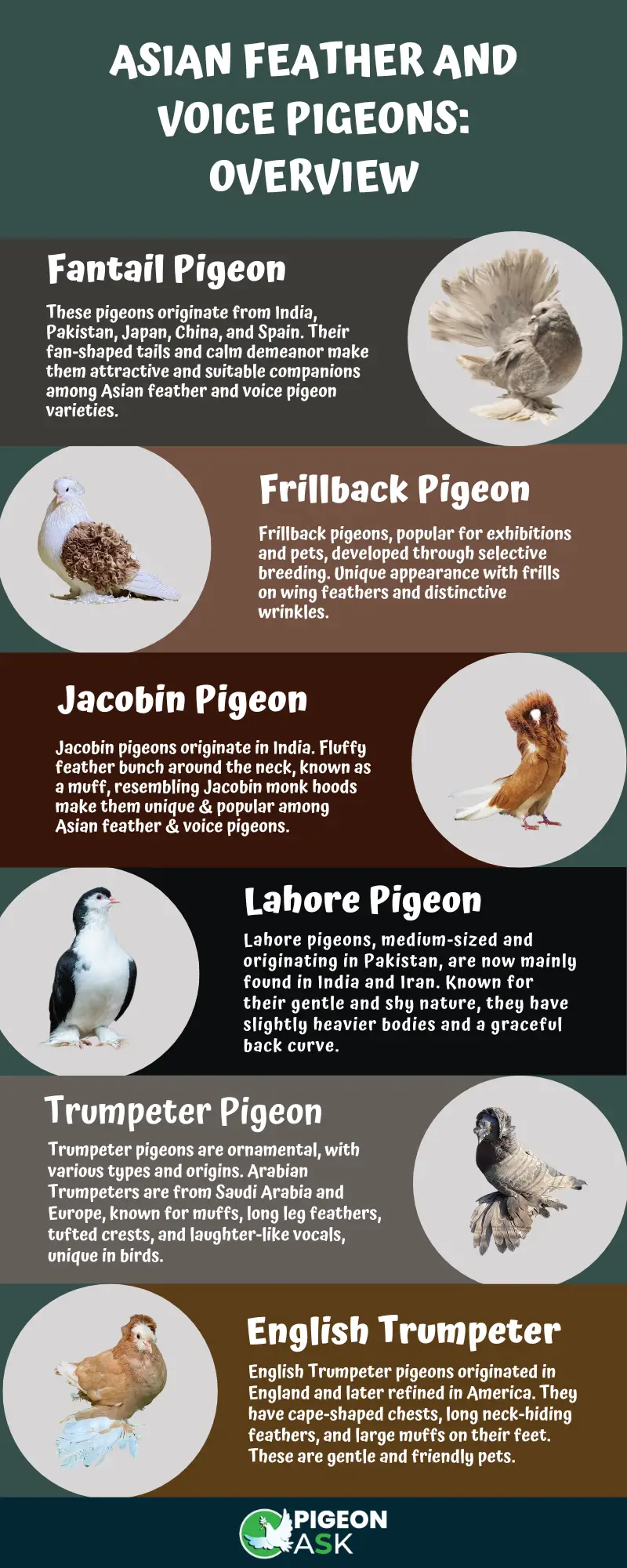
Though they are found in different parts of the world, most of these breeds have their origin mostly in different parts of Asia including India, Pakistan and Middle East.
These pigeons have some common characteristics and physical structures that make them different from other pigeons.
So, these pigeons are considered under a category having certain characteristics, not a specific breed. An overview of Asian feather and voice pigeons is listed below.
| Classification | Measurements |
|---|---|
| Scientific Name: Columba Livia | Length: 30-37 cm |
| Other Name: Trumpeter, FanTail, Jacobin, Frillback | Wingspan: 19.7-26.4 inches |
| Family: Fancy Pigeon | Weight: 350 gm |
Among different varieties of Asian feather and voice pigeons, the most popular and well-known are described here briefly.
Fantail
These are one of the fanciest pigeons that are kept as pets in different households. Fantail pigeons mostly originated in India, Pakistan, Japan, China and Spain, but they have been bred from multiple domestic pigeon breeds.
Their fan-shaped tails with a large number of long feathers make them attractive and beautiful. Among other varieties of Asian feather and voice pigeons, Fantails are the most calm and docile ones that can make good pets.
Frillback
Generally, Frillback pigeons are domestic ones that are mainly developed through selective and mixed breeding. Though these pigeons are mostly used for exhibition and show purposes and yes, you can raise them as pets.
They are popular among other varieties because of their unique appearance. These pigeons have frills on the wing feathers that form distinct curls at the end and cover their entire wing area. Besides, they have distinctive wrinkles in their flight feathers and tail end.
Jacobin
Among different breeds of Asian feather and voice pigeons, Jacobins are recognized as fancy ones for having a bunch of fluffy feathers around their neck.
This type of feather arrangement of Jacobin is known as muff that is similar to the Jacobin monk hoods. These pigeons originated in India and are developed through breeding all over Asia.
Lahore
This variety of Asian feather and voice pigeons are medium-sized pigeons that originated in Lahore, Pakistan. But they have their present locality, mostly in India and Iran.
They are basically known for their gentle and shy nature with a docile temperament. These pigeons have slightly heavier body with a smooth and graceful curve in their back part.
Trumpeter
These pigeons are mainly used for ornamental and exhibition purposes. There are different varieties of Trumpeter that have their own origin and locality.
For example, the Arabian Trumpeter originated in Saudi Arabia, but they also have their locality outside Asia, specially in Europe.
Large muffs, long leg feathers and a tufted crest are some of the distinctive features of these pigeons. Additionally, they have a low-scale laughter-like vocal, which is unique in bird species.
English Trumpeter
Though the origin of the English Trumpeter is in England, the modern breed of these pigeons was developed in America. They have a cape-shaped chest hiding their neck in long feathers.
Large muffs on the feet are one of the most distinctive features of these pigeons. English trumpeters are a great choice as pets because of their gentle nature and friendly behavior.
Looking for more articles about pigeon types:
Common Physical Appearance and Unique Features
Asian feathers and voice pigeons have long wings and slimmer bodies compared to other domestic breeds. Their body length is about 30-37 cm, smaller than the pigeons living in the wild. The average weight of a mature pigeon is about 350gm.
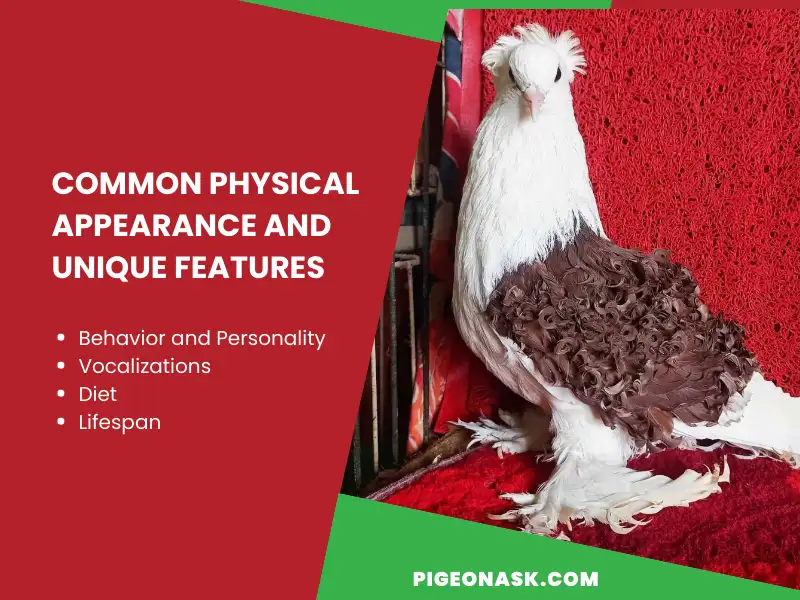
Generally, these pigeons do not have any leg feathers. But some of the mixed breeds and wild varieties might have feathers on their legs. They have black eyes with irises of different shades, including orange and red.
Even though their feathers are black, white, and gray, they often have bluish-plain heads and necks with wing feathers in reddish and greenish shades. Most of them have short and blunt beaks.
Behavior and Personality
These pigeons love to live in flocks by building a community among themselves. Usually, they are seen living in their nest till the end of their life.
Asian feather and voice pigeons also love human companionship and tend to keep loyal if they are domesticated. They are easy to tame and can recognize humans by identifying the differences in vocals and facial features.
Generally, they are rarely seen engaged in territorial fighting. But it can happen during the breeding season. They can be territorial and engage in display fights showing excessive body movements.
Vocalizations
Like most other varieties of pigeons, the Asian feather and voice pigeons also produce different sounds depending on their situation. Usually, their voice is low and often unclear.
When attracting another pigeon of the opposite sex, they produce a calm and cooing sound from their nest.
Besides, these pigeons can also produce a grunting-like sound when they know about approaching dangers. In such situations, they make noise with their feathers by moving their wings at a certain frequency.
Diet
Asian feather and voice pigeons generally live on seeds, grains, fruits, and vegetables. Often, they eat living insects like worms, snails, and small spiders as an occasional meaty meal.
Besides, different types of grains and nuts are also one of their favorite foods. For pigeons that live near the tropical regions of Asia, fruits and seeds are their staple food in daily meals.
The domestic ones occasionally eat commercial foods that contain a mix of seeds, millet, cracked wheat, and corn. Often these foods include chunks of berries to enhance the taste as well as increase the vitamin intake.
Lifespan
Pigeons living in nature and the wild can live up to 10 to 15 years. In contrast, domestic pigeons often live up to 30 years.
Asian feather and voice pigeons have a relatively long lifespan compared to other birds. But the span depends on several factors, including place of habitat and health condition.
The life cycle for domestic pigeons is a bit higher compared to the wild ones as they are free from predator attacks and consume more nutritious foods.
The Popularity and Cultural Significance of Asian Feather and Voice Pigeons
These pigeons have gained popularity among pigeon lovers because of their gentle nature and friendly behavior. Besides domesticating, they are also used in different shows and competitions that have increased their popularity significantly.
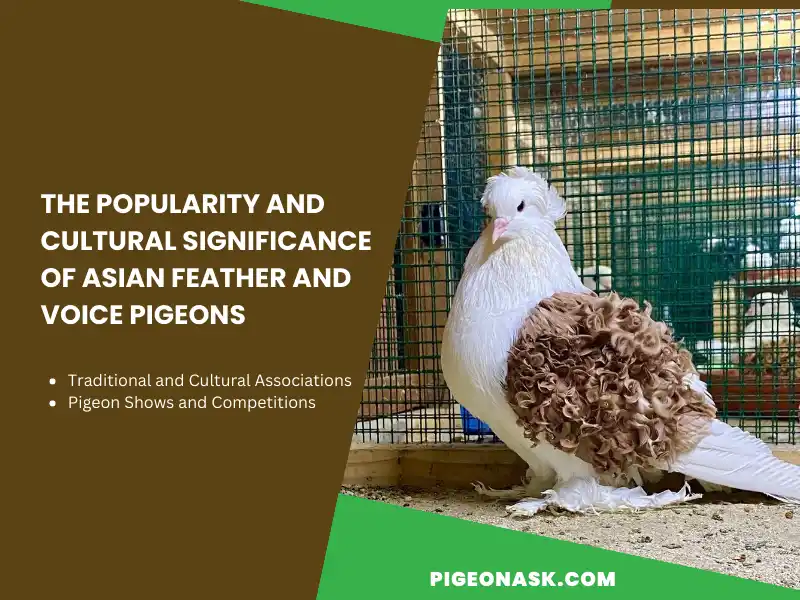
Traditional and Cultural Associations
Since Asian feather and voice pigeons were discovered, they were considered a symbol of peace and love all over the world.
In different cultural and traditional events, they were used as show birds to represent unity, equality and freedom.
Besides, people also use them for manifesting religious and cultural groups that promote purity, simplicity, happiness and hope.
Pigeon Shows and Competitions
Often people train several breeds of Asian feather and voice pigeons to participate in different shows and competitions. These pigeons are not domesticated and only used for specific performances in events.
Different pigeon shows and competitions include racing, walking on a wire and flaunting unique appearances of each breed.
Generally, Asian feather and voice pigeons are not trained for racing purposes and are mostly used as show birds.
Breeding and Care Tips for Asian Feather and Voice Pigeons
There are a lot of pigeon breeds that are domesticated and kept in shelters indoors. But can these pigeons be kept as indoor pets?
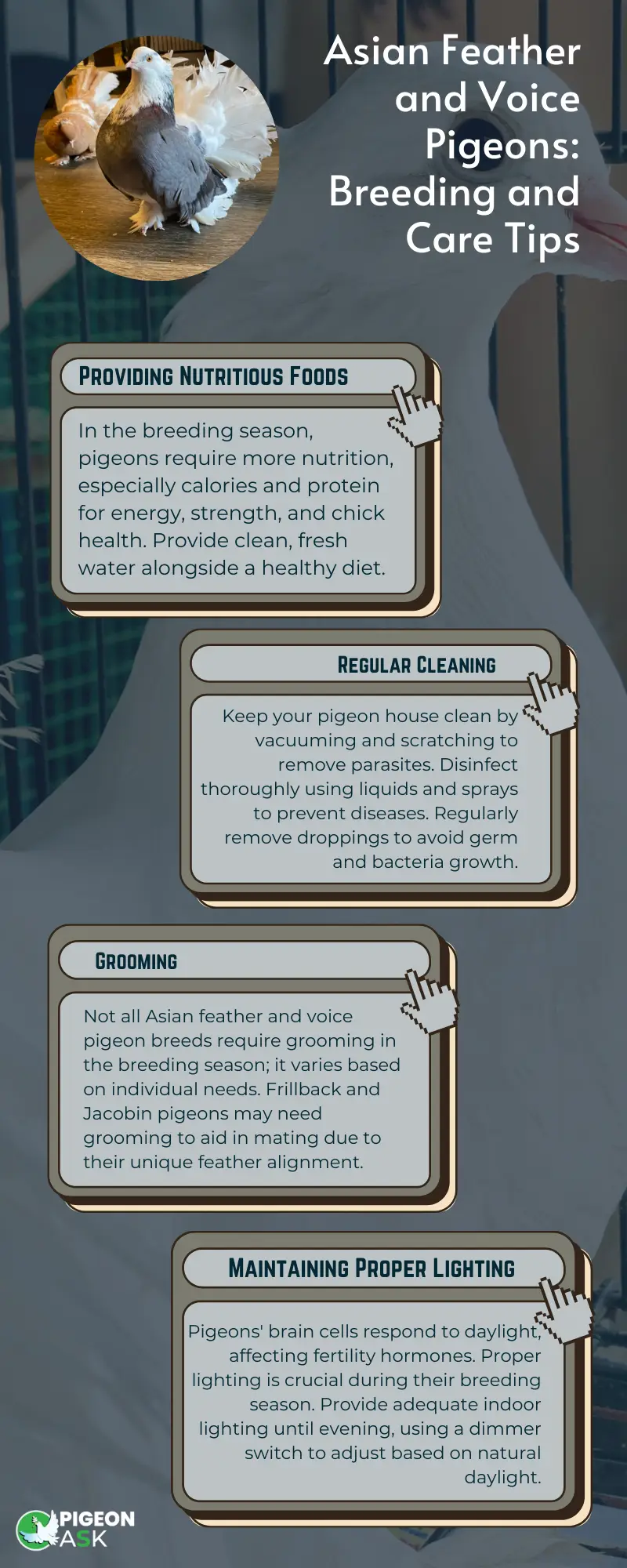
Actually, Asian feather and voice pigeons can be domesticated easily and can live indoors. But they also love hoping and roaming outdoor locations and so it is better to build them housing with outdoor enclosures.
When the breeding season is at its peak for your pigeons, you need to take care of them well so that they remain safe and healthy in their indoor housing. Here we have started a brief discussion about the breeding and care guide of these pigeons.
Providing Nutritious Foods
During the breeding season, pigeons need more nutrition compared to regular days. So, make sure to add enough calories and protein to their daily diet.
Calories will provide them energy and strength that is required during fertilization. On the other hand, protein will keep the chicks healthy and risk-free. Besides healthy food, make sure to give them access to clean and fresh water throughout the day.
Regular Cleaning
Clean the house of your pigeons by vacuuming and scratching to remove all traces of existing parasites. It will help to prevent any contamination that can promote diseases in your pigeons.
You can also use disinfecting liquids and sprays to disinfect the entire housing thoroughly. Besides, remove the droppings of the pigeons regularly to prevent the growth of germs and bacteria.
Grooming
Actually, not all breeds of Asian feather and voice pigeons need grooming during their breeding season. It depends on the individual requirements of certain breeds.
The Frillback and Jacobin pigeons have distinctive feather alignment in their entire body that can often cause problems while breeding. That is why, often breeders tend to groom them by trimming the feathers so that they can mate easily.
Maintaining Proper Lighting
The brain cells of pigeons respond according to the daylight hours and it affects the hormones that trigger the activities associated with fertility. So, it is required to maintain proper lighting during their breeding season.
Some weeks prior to their mating period, make sure to provide enough lighting inside their housing till evening. Install a dimmer switch to adjust the lighting depending on the natural daylight.
Reproduction and Migration
Asian feather and voice pigeons reproduce their offspring by mating. Each breed has an individual schedule and duration of the reproduction period, but the overall reproduction system is almost the same for every breed.
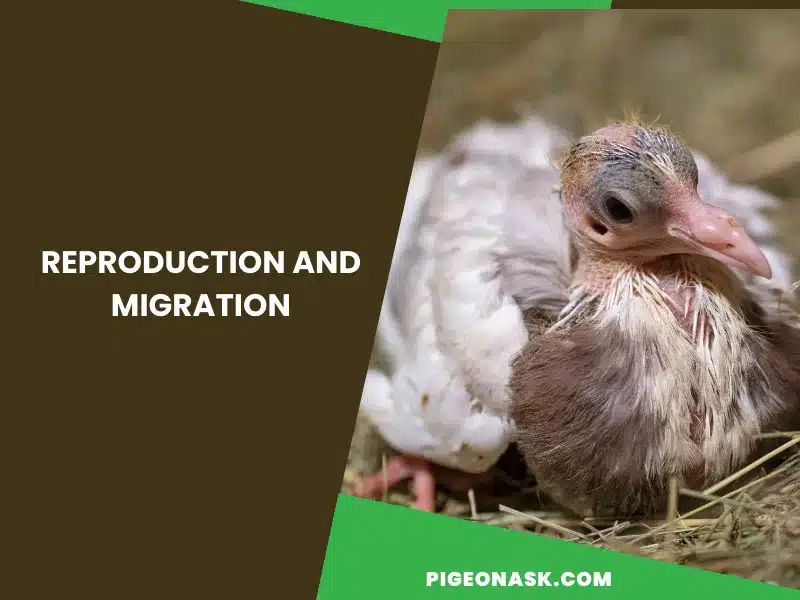
After mating, the female pigeons lay eggs and the eggs take at least 15-17 days to hatch. Adult pigeons take care of the babies until they are mature enough to find their own food.
Like most other pigeons, the Asian feather and voice pigeons don’t migrate to other areas. The truth is these birds were bred for show purposes and lack the flight strength for migration.
However, they can adapt to the environment quite well and don’t feel the necessity to migrate in harsh weather conditions.
Geographic Distribution of These Breeds in Asia
Most of the breeds of Asian feather and voice pigeons are found in several regions of Asia that include countries like Pakistan, Iran, India, China, Japan and Saudi Arabia.
Among these pigeons, the origin of Fantail pigeons is distributed all over Asia, including India, Japan, Pakistan and China.
On the other hand, some breeds are found in certain countries of Asia. For instance, Lahore pigeons originated in Pakistan, the Arabian Trumpeter in Saudi Arabia and the Jacobin in India.
Conclusion
Among different breeds of pigeons, the Asian feather and voice pigeons are really one of a kind because of their gentle and calm nature. They are attractive, interesting, and friendly pets that could be your companion for life.
Hopefully, this article has provided all the information about these pigeons, including their behavior, nature, food, and habitat, so that you can know these details before keeping them as your pets.
References:
- https://simple.wikipedia.org/wiki/Jacobin_pigeon
- https://www.pigeoncontrolresourcecentre.org/html/about-pigeons.html
- https://www.discovermagazine.com/planet-earth/pigeons
Image Credits:
- Canva.com/photos
- https://www.instagram.com/p/CXTv_P5vSDm/
- https://www.instagram.com/szarygolomp/
- https://www.gettyimages.dk/photos/jacobin-pigeon
- https://www.instagram.com/naeem_royal_pigeon/
- https://www.instagram.com/zeeshans.loft/
